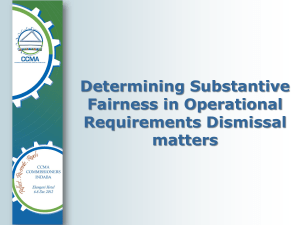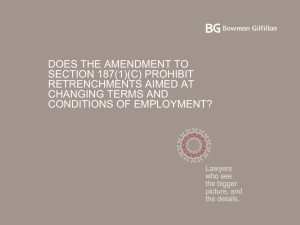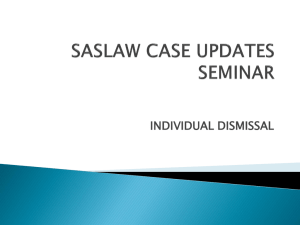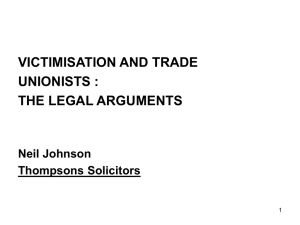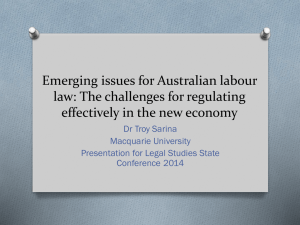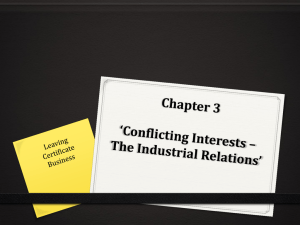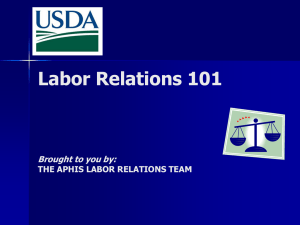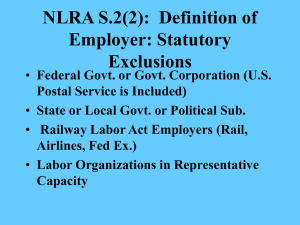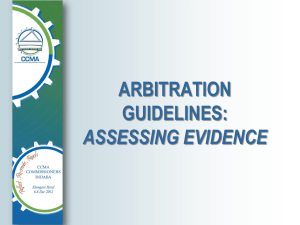Right not to be unfairly dismissed
advertisement
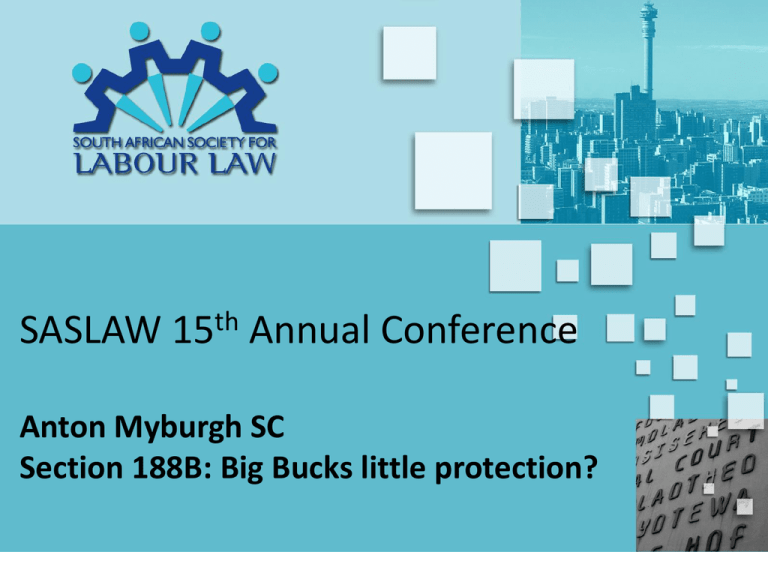
SASLAW 15th Annual Conference Anton Myburgh SC Section 188B: Big Bucks little protection? Outline • • • • • • • • • • • Text and operation of s188B Explanatory memorandum SASLAW’s comments 2010 Bill Right not to be unfairly dismissed Problem of categorisation and inflexibility Problem of costs associated with dismissal Threshold and bargaining power Exclusion of s187(1)(g) Contractual claims Problems and puzzles The text of s188B ‘(1) This section applies to employees who earn, as at the date of dismissal, more than an amount determined by the Minister in accordance with subsection (4). (2) Despite section 188(1) the dismissal of an employee to whom this section applies is, if it is not automatically unfair as contemplated in section 187(1)(a) to (f) or (h), deemed to be for a fair reason and to have been effected in accordance with a fair procedure as contemplated in section 188 if the employer gives the employee the notice referred to in subsection (3) or pays the employee in lieu of that notice on or before the date of dismissal. (3) The notice referred to in subsection (2) is three months or any longer period specified in the employee’s contract of employment and must be given in writing. The text of s188B (cont) (4) The Minister must from time to time in consultation with NEDLAC and by notice in the Gazette make a determination of the amount referred to in subsection (1). In making that determination the Minister must take into account the extent to which employees, by reason of their earnings level, level of skill or position, have sufficient bargaining power to ensure that adequate provision may be made in their contracts of employment for protection against unfair dismissal. (5) This section will apply to contracts of employment concluded before the commencement date of this section with effect from two years after the commencement date of this section.’ The operation of s188B • Only applies to employees above threshold • Only applies to dismissals (not ULPs) • Bargaining power assumption • Does not limit employer’s right to dismiss • Employee can challenge summary dismissal The operation of s188B (cont) • No claim for ordinary unfair dismissal if 3 months’ notice given • Employee retains right to claim automatically unfair dismissal • But not section 187(1)(g) – section 197 • Transitional provisions – immediate; 2 year suspension Explanatory memorandum: problem 1 • • • ‘At the heart of the change is the disproportionate cost, complexity, and impact on an employer’s operations of procedures to terminate the employment of high earning employees … where the reason for doing so may not fall clearly and neatly within the fair reasons for dismissal specified in s188. These reasons [examples having been given] do not comfortably fall within the reasons for dismissal specified in s188, but are widely recognised as legitimate reasons to replace senior executives. The uncertainty created by the application of s188 in these situations leads to significant inflexibility and inefficiency at the tops levels of a business or state enterprise.’ Explanatory memorandum: problem 2 • ‘At the same time, the cost of asserting discipline and performance standards at senior levels is notoriously difficult to manage, and conflict at this senior executive level that results from efforts to terminate employment imposes significant constraints, measured in cost and efficiency, on both public and private sector employers.’ SASLAW comments • ‘Although a few members consider the section to be pragmatic, the predominant view is that the explanation given in the Explanatory Memorandum for this amendment does not justify depriving the employees of their right not to be unfairly dismissed. On the face of it, the section appears vulnerable to constitutional challenge as there are other means of addressing the concerns expressed in the Explanatory Memorandum.’ 2010 Bill (s187A) • ‘An employee earning in excess of an amount determined by the Minister by notice in the Gazette, may not refer labour disputes in respect of the provisions of section 185, 186 [whole of], 188, 189, 189A and 197 to the CCMA.’ • No entry mechanism to Labour Court 2010 Explanatory Memorandum • ‘The amendment seeks to exclude employees earning more than the prescribed threshold from referring their labour disputes to the CCMA. This will ensure that vulnerable employees are not prejudiced because of the delays caused by the volume of complaints from employees who can afford to approach the courts.’ • Regulatory Impact Assessment 2010 versus 2012 • 2010 proposal had no quid pro quo • 2010 proposal also excluded ULPs • Motivation very different Right not to be unfairly dismissed: s185 • Essential to the constitutional right • One of the most important manifestations of it • Consistent with the main object of labour law s188B versus s185 • Right is only as good as the remedy • s188B deprives employees of a remedy in respect of ordinary unfair dismissals • If employees do not have sufficient bargaining power to protect themselves, then the legislature has traded the right not to be unfairly dismissed for 3 months’ notice SA Post Office v Mampeule (LAC) • ‘A heavier onus rests on a party which contends that it is permissible to contract out of the right not to be unfairly dismissed in terms of the Act. … parties to an employment contract cannot contract out of the protection against unfair dismissal afforded to an employee whether through the device of “automatic termination” provisions or otherwise because the Act has been promulgated not only to cater for an individual’s interest but the public’s interest.’ Problem of categorisation and inflexibility • Problem certainly exists • It has arisen as a consequence of: • • • limitation on permissible grounds of dismissal defining them narrowly maintaining rigged distinctions between them There are at least 4 ways to address the problem 1. Expand the meaning of incapacity and operational requirements 2. Adopt a flexible performance informal approach to poor 3. Loosen the strict divide between permissible grounds of dismissal 4. Adopt the reasonable employer test in relation to senior executives 1. Expand meaning of incapacity and operational requirements • Samancor v MEIBC (LAC) – operational incapacity and incompatibility are a species of incapacity • ‘Incompatibility relates, essentially, to the subjective relationship of an employer and other co-workers within an employment environment regarding an employee’s inability or failure to maintain harmonious relationships with his peers.’ 1. Expand meaning of incapacity and operational requirements (cont) • Brassey: ‘The definition of operational requirements should be interpreted broadly enough to encompass all dismissals originating in causes on the side of the employer. So read, it would encompass dismissals for incompatibility … or as a result of the breakdown in trust and confidence in the employee. To interpret it otherwise would mean that the Act made no provision for cases of this sort …. This conclusion … is contrary to the intention of the drafters, who were obviously seeking a comprehensive codification of unfair dismissal law.’ 2. Adopt a flexible approach to poor performance • Item 9(a) of the Code of Good Practice: failed to meet a ‘performance standard’ • Interpreted as meaning a measure of performance, i.e. a standard by which performance is measured • Limits to formal performance appraisals • Examples – soft people issues 2. Adopt a flexible approach to poor performance (cont) • Eskom v Mokoena (LAC): ‘The attitude adopted by the respondent was that he required the individual complaints against him to be proven as a fact before he would respond thereto. This was tantamount to a refusal to come to grips with and respond to the fact that there was a widespread perception of him as an incompetent manager. … His very refusal to take steps to address that perception pointed to his unsuitability to hold the position of manager.’ 2. Adopt a flexible approach to poor performance (cont) • Eskom v Mokoena (LAC): ‘Sight should not be lost of the fact that the present case is to be distinguished from the case of a dismissal for misconduct. In the latter case the misconduct itself must be established by the employer. In the present case what the appellant was required to establish was the respondent’s alleged incapacity. It was not necessary for that purpose that the alleged conduct on the part of the respondent which formed the subject of the complaints made against him to be established as if that conduct constituted misconduct justifying the respondent’s dismissal. It was the widespread dissatisfaction of the staff in the respondent’s division and in the power station, of which the complaints were evidence, and their perception of the respondent as being incapable that was the problem. It was that problem that had to be conveyed to the respondent and on which the appellant was required to give him a hearing.’ 2. Adopt a flexible approach to poor performance (cont) • On this approach: • Senior managers must address allegations / perceptions of poor performance. • They do not have to be established in the manner applicable in a misconduct case. • The employer does not need to establish a formal performance standard and that the employee failed to measure up to it. • This is a different and much less onerous approach than that required by the Code of Good Practice. 3. Loosen the divide between the 3 permissible grounds of dismissal • Goldfields Logistics v Smith (LAC): ‘In my view, there would be instances where a legitimate operational requirement exists, which would justify a dismissal based on operational requirements and also a fair reason on the basis of which an employer may discipline the employee for misconduct which would lead to a dismissal. Such a scenario should give an employer a choice of procedure to follow.’ • Example – poor time-keeping 4. Adopt the reasonable employer test • JDG Trading v Brunsdon (LAC): ‘I would think that where an employer on reasonable grounds comes to the conclusion that a senior management employee is unsuited to the position which he holds, the scope for having such a conclusion overturned in a court of law is small. It is in the highest degree desirable that an employer should, in the interests of efficiency, be entitled to chose with as much freedom as is compatible with the honest exercise of a discretion, who it wants at or near the helm of its enterprise. Qualities like leadership, resolve, business acumen, judgment and effective administration are not readily provable in a court. A deficiency in such qualities is not readily provable either.’ 4. Adopt the reasonable employer test (cont) • This is precisely the problem identified in the explanatory memorandum 4. Adopt the reasonable employer test (cont) • The solution was stated in JDG Trading v Brunsdon (LAC): ‘In the realm of dismissal for incapability, it is important that the employer’s business should not have to suffer, to the detriment of all concerned, through the ineptitude or inefficiency of a particular employee. However, it is also important that the employee whose work is causing dissatisfaction should be treated fairly. The question for the tribunal is whether the employer has satisfied them that he genuinely believed on reasonable grounds that the employee was incapable.’ 4. Adopt the reasonable employer test (cont) • In relation only to senior managers • Limit to poor performance / incapability • Precedent exists for a different test for substantive fairness – s189A(19) Problem of costs associated with internal proceedings • Problem certainly exists • But it is the product of inflexible law • And the use of criminal justice model of procedural fairness • Example – SA Custodial Services Problem of costs associated with internal proceedings (cont) • National Bioinformatics Network Trust v Jacobson (LC): ‘The applicant chose to ignore the informal workplace procedures prescribed by the Code of Good Practice and to conduct a disciplinary enquiry, at great expense to the taxpayer no doubt, in a form that would make any criminal court proud. I have previously had occasion to comment on the profitable cottage industry that has developed from the application of unnecessarily complex workplace disciplinary procedures, and how inimical the actions of some practitioners, consultants, socalled trade unions and employer organizations and the various other carpetbaggers who populate this industry are in relation to the objectives underlying the LRA.’ Threshold and bargaining power • Grogan: ‘To take into account the employee’s salary as an indication of bargaining power renders the inquiry entirely circular, because the end point of the inquiry is to determine the salary. In any event, a threshold set by earnings must inevitably be arbitrary – why should an employee earning, say, R19 999 a month be able to be unfairly dismissed, but not an employee earning R20 000? Level of skills is also hardly a reliable indicator of an employee’s pre-appointment negotiating power, because many jobs requiring high levels of skills are not particularly well paid, and some positions in the public sector, open to “deployees” of the ruling party, require no skills at all. This leaves “position”, which is probably the most sensible consideration to take into account when determining which employees should be deprived of … free services … if they happen to get the chop.’ Threshold and bargaining power (cont) • Assumption: sufficient bargaining power to ensure that ‘adequate provision is made in their contracts of employment for protection against unfair dismissal’. • Private dispute resolution – why would employer agree? • Increased exit package – market forces? Threshold and bargaining power (cont) • If employees don’t have sufficient bargaining power, then s188B equates to the forfeiture of the right not to be unfairly dismissed in return for 3 months’ notice • Seems questionable whether this will pass constitutional scrutiny, particularly given the motivation for the amendment The exclusion of s187(1)(g) • Why exclude this? • The implications? The contractual claims • Grogan: ‘Apart from claims for automatically unfair dismissal, opulent employees will be confined to challenging their dismissals under the common law. Unless they have negotiated contractual provisions that bind the employer to dismiss them fairly … these employees will find little assistance from the courts under that head, at least while judgments like SA Maritime Safety Authority v McKenzie … remain binding. [It] knocked on the head the argument that requirements of fairness can be implied into or viewed as tacit terms of contracts of employment.’ Problems and puzzles • If the true reason for an employee’s dismissal (on 3 months’ notice) is the employer’s operational requirements, will the employee be entitled to severance pay? • What about the employee who through his dismissal (on 3 months’ notice) loses out on massive deferred compensation which would be due in a year’s time? • Could an employer in the throes of a protracted disciplinary enquiry up the employee’s salary to the threshold and then give him 3 months’ notice? • Can an employer ward off a claim for constructive dismissal by paying the employee in lieu of 3 months’ notice on the day of his resignation? Conclusion Big bucks little protection? Citations – in order of reference • SA Post Office v Mampeule [2010] 10 BLLR 1052 (LAC) • Samancor Tubatse Ferrochrome v MEIBC & others [2010] 8 BLLR 824 (LAC) • Brassey Commentary on the Labour Relations Act • Eskom v Mokoena [1997] 8 BLLR 965 (LAC) • Goldfields Logistics (Pty) Ltd v Smith (unreported LAC judgment, case no. JA42/08 dated 24/08/2010) Citations – in order of reference (cont) • JDG Trading (Pty) Ltd t/a Price ‘n Pride v Brunsdon [2000] 1 BLLR 1 (LAC) • Trustees for the time being of the National Bioinformatics Network Trust v Jacobson & others (2009) 30 ILJ 2513 (LC) • Grogan ‘What’s in store – the coming amendments (2012) 28 (4) Employment Law • SA Maritime Safety Authority v McKenzie [2010] 5 BLLR 488 (SCA)
